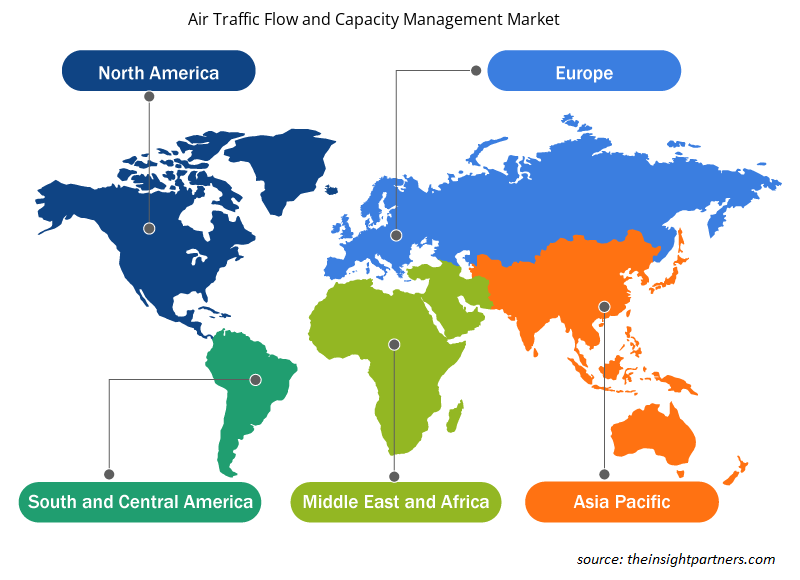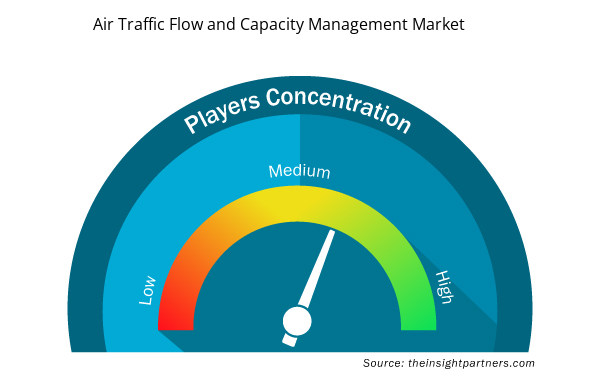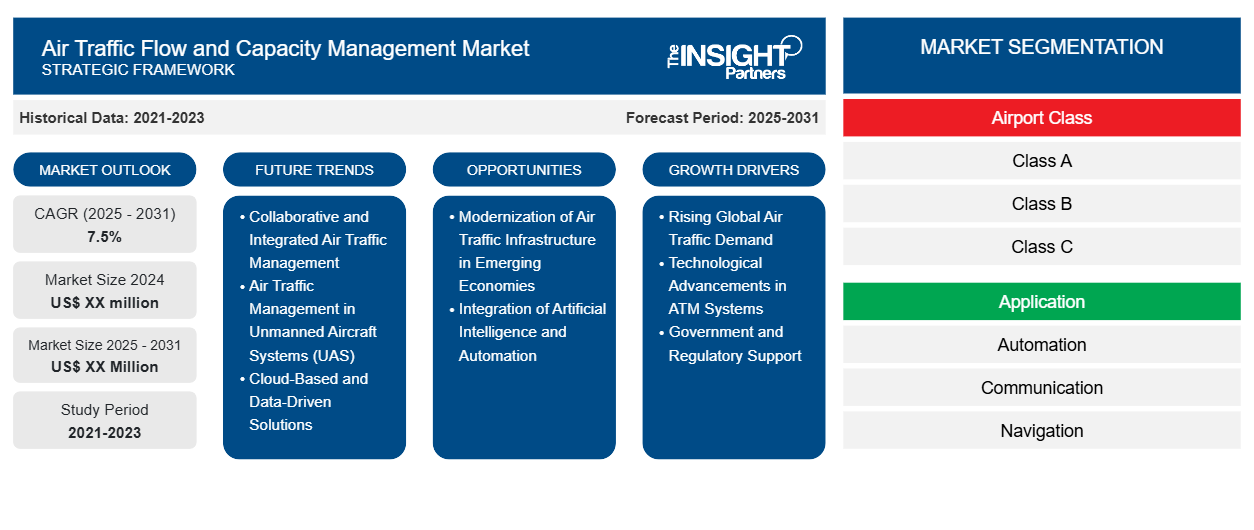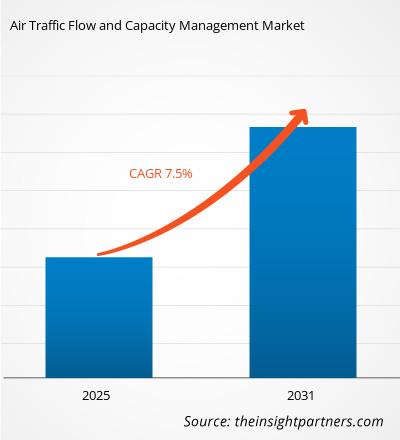Es wird erwartet, dass der Markt für Flugverkehrsfluss- und Kapazitätsmanagement von 2023 bis 2031 eine durchschnittliche jährliche Wachstumsrate (CAGR) von 7,5 % verzeichnet, wobei die Marktgröße von XX Millionen US-Dollar im Jahr 2023 auf XX Millionen US-Dollar im Jahr 2031 wächst.
Der Bericht ist segmentiert nach Flughafenklasse (Klasse A, Klasse B, Klasse C); Anwendung (Automatisierung, Kommunikation, Navigation, Simulation, Überwachung); Endbenutzer (zivil und kommerziell, Militär und Verteidigung). Die globale Analyse ist weiter auf regionaler Ebene und nach wichtigen Ländern aufgeschlüsselt. Der Bericht bietet den Wert in USD für die oben genannte Analyse und Segmente.
Zweck des Berichts
Der Bericht „Air Traffic Flow and Capacity Management Market“ von The Insight Partners zielt darauf ab, die aktuelle Situation und das zukünftige Wachstum sowie die wichtigsten Antriebsfaktoren, Herausforderungen und Chancen zu beschreiben. Dies wird verschiedenen Geschäftspartnern Einblicke geben, wie zum Beispiel:
- Technologieanbieter/-hersteller: Um die sich entwickelnde Marktdynamik zu verstehen und die potenziellen Wachstumschancen zu kennen, damit sie fundierte strategische Entscheidungen treffen können.
- Investoren: Durchführung einer umfassenden Trendanalyse hinsichtlich der Marktwachstumsrate, der finanziellen Marktprognosen und der Chancen entlang der Wertschöpfungskette.
- Regulierungsbehörden: Zur Regulierung von Richtlinien und Überwachungsaktivitäten auf dem Markt mit dem Ziel, Missbrauch zu minimieren, das Vertrauen der Anleger zu bewahren und die Integrität und Stabilität des Marktes aufrechtzuerhalten.
Marktsegmentierung für Flugverkehrsfluss- und Kapazitätsmanagement
Flughafenklasse
- Klasse A
- Klasse B
- Klasse C
Anwendung
- Automatisierung
- Kommunikation
- Navigation
- Simulation
- Überwachung
Endbenutzer
- Zivil- und Handelsrecht
- Militär und Verteidigung
Geographie
- Nordamerika
- Europa
- Asien-Pazifik
- Süd- und Mittelamerika
- Naher Osten und Afrika
Geographie
- Nordamerika
- Europa
- Asien-Pazifik
- Süd- und Mittelamerika
- Naher Osten und Afrika
Passen Sie diesen Bericht Ihren Anforderungen an
Sie erhalten kostenlos individuelle Anpassungen an jedem Bericht, einschließlich Teilen dieses Berichts oder einer Analyse auf Länderebene, eines Excel-Datenpakets sowie tolle Angebote und Rabatte für Start-ups und Universitäten.
- Holen Sie sich die wichtigsten Markttrends aus diesem Bericht.Dieses KOSTENLOSE Beispiel umfasst eine Datenanalyse von Markttrends bis hin zu Schätzungen und Prognosen.
Wachstumstreiber auf dem Markt für Flugverkehrsfluss- und Kapazitätsmanagement
- Steigende globale Nachfrage nach Flugverkehr: Das anhaltende Wachstum des globalen Flugverkehrs, das durch steigende Passagierzahlen und Frachtnachfrage angetrieben wird, ist ein wichtiger Treiber des Marktes für Flugverkehrsfluss- und Kapazitätsmanagement. Da sich der Flugverkehr von der Pandemie erholt und zunimmt, müssen Flughäfen und Flugsicherungsdienstleister (ANSPs) den Luftraum und die Flughafenkapazität optimieren, um diesen Zustrom zu bewältigen. Um dieses Wachstum zu bewältigen und gleichzeitig Sicherheit und Effizienz aufrechtzuerhalten, sind fortschrittliche Systeme für das Flugverkehrsmanagement (ATM) erforderlich, um einen reibungslosen und effektiven Betrieb zu gewährleisten. Der Anstieg des Flugverkehrs belastet die bestehende Infrastruktur und erfordert Verbesserungen im Flussmanagement, um Staus und Verspätungen zu vermeiden.
- Technologische Fortschritte bei ATM-Systemen: Technologische Innovationen, darunter der Einsatz künstlicher Intelligenz (KI), maschinellem Lernen (ML), Automatisierung und fortschrittlicher Datenanalyse, verändern Flugverkehrsmanagementsysteme. Diese Fortschritte ermöglichen eine Echtzeitoptimierung des Flugverkehrsflusses, eine bessere Vorhersage von Engpässen und eine effizientere Nutzung der verfügbaren Kapazität. Automatisierung in Flugsicherungstürmen und fortschrittliche Flugmanagementsysteme reduzieren menschliche Fehler und erhöhen die Betriebseffizienz, was den Bedarf an verbesserten Lösungen im Flugverkehrsfluss- und Kapazitätsmanagement erhöht.
- Unterstützung durch Regierungen und Regulierungsbehörden: Regierungen und Regulierungsbehörden auf der ganzen Welt legen zunehmend Wert auf die Modernisierung von Flugverkehrsmanagementsystemen, um die Sicherheit zu erhöhen, Verspätungen zu reduzieren und die Umwelteffizienz zu verbessern. Regulierungsinitiativen wie der einheitliche europäische Luftraum (Single European Sky, SES) in Europa drängen auf eine kollaborative und integrierte Verwaltung des Luftraums, was Investitionen in Lösungen zur Steuerung des Flugverkehrsflusses vorantreibt. Darüber hinaus fördern Regierungen die Entwicklung effizienterer ATM-Systeme, um Nachhaltigkeitsziele zu erreichen und den Kohlenstoffausstoß durch die Optimierung von Flugrouten und Luftraumnutzung zu reduzieren.
Zukünftige Trends auf dem Markt für Flugverkehrsfluss- und Kapazitätsmanagement
- Kollaboratives und integriertes Flugverkehrsmanagement: Ein wichtiger Trend auf dem Markt für Flugverkehrsfluss- und Kapazitätsmanagement ist die Verlagerung hin zu kollaborativen und integrierten Flugverkehrsmanagementsystemen. Initiativen wie SESAR (Single European Sky ATM Research) in Europa und NextGen in den USA zielen darauf ab, eine nahtlose und einheitliche Flugverkehrskontrollinfrastruktur über Regionen hinweg zu schaffen. Diese Zusammenarbeit ermöglicht eine bessere Koordination zwischen Fluglotsen, Fluggesellschaften und Flughäfen und verbessert den Flugverkehrsfluss über nationale Grenzen hinweg. Integrierte Systeme erleichtern den Datenaustausch in Echtzeit und verbessern die Entscheidungsfindung, wodurch Kapazitätsengpässe bewältigt und Verspätungen reduziert werden können.
- Flugverkehrsmanagement in unbemannten Flugsystemen (UAS): Der Aufstieg von Drohnen und unbemannten Flugsystemen (UAS) ist ein weiterer neuer Trend, der das Flugverkehrsmanagement neu gestaltet. Das UAS-Verkehrsmanagement (UTM) wird zu einem wesentlichen Aspekt des Flugverkehrsmanagementmarktes, da diese Systeme eine dedizierte Infrastruktur für die sichere Integration mit bemannten Flügen benötigen. Regierungen und Aufsichtsbehörden entwickeln UTM-Frameworks, um den sicheren und effizienten Betrieb von Drohnen in überlasteten Lufträumen zu gewährleisten. Mit der zunehmenden kommerziellen Nutzung von Drohnen wird UTM zu einem entscheidenden Teil der Verwaltung der gesamten Flugverkehrskapazität werden, was einen Trend zur Einbeziehung des Drohnenmanagements in traditionelle ATM-Systeme hervorruft.
- Cloudbasierte und datengesteuerte Lösungen: Systeme zur Verwaltung des Flugverkehrsflusses und der Kapazität setzen zunehmend auf Cloud-basierte Technologien und datengesteuerte Lösungen. Diese Systeme bieten erhebliche Vorteile, darunter verbesserte Skalierbarkeit, Echtzeit-Datenzugriff und kostengünstige Bereitstellung. Cloudbasierte Systeme ermöglichen die Zentralisierung von Flugverkehrsmanagementvorgängen und erleichtern so die Koordination zwischen mehreren Beteiligten, darunter Flughäfen, Fluggesellschaften und Flugnavigationsdienstleister. Datenanalysen spielen eine Schlüsselrolle bei der Optimierung des Flugverkehrs, der Vorhersage von Engpässen und der Verbesserung der Entscheidungsfindung durch die Analyse historischer und Echtzeit-Flugdaten. Diese Technologien sind entscheidend, um reaktionsschnellere und flexiblere Lösungen für das Flugverkehrsmanagement zu ermöglichen
Marktchancen für Flugverkehrsfluss- und Kapazitätsmanagement
- Modernisierung der Flugverkehrsinfrastruktur in Schwellenländern: Schwellenländer, insbesondere im asiatisch-pazifischen Raum, in Afrika und Lateinamerika, investieren massiv in die Modernisierung ihrer Flugverkehrsmanagementinfrastruktur. Da der Flugverkehr in diesen Regionen zunimmt, bietet sich eine große Chance, neue und fortschrittliche Systeme zur Flugverkehrsfluss- und Kapazitätsverwaltung einzuführen. Diese Regionen möchten die Flughafenkapazität erhöhen, die Sicherheit verbessern und die Nutzung des Luftraums durch moderne ATM-Technologien optimieren. Unternehmen, die hochmoderne Lösungen für das Flugverkehrsmanagement anbieten, können von diesen wachsenden Märkten profitieren, indem sie skalierbare, kostengünstige Systeme bereitstellen, die den Anforderungen der expandierenden Luftfahrtindustrie gerecht werden.
- Integration von künstlicher Intelligenz und Automatisierung: Die Integration von KI, maschinellem Lernen und Automatisierung in das Flugverkehrsflussmanagement bietet erhebliche Möglichkeiten zur Verbesserung der Betriebseffizienz. KI kann riesige Mengen an Flugdaten analysieren, um Verkehrsmuster vorherzusagen, Flugrouten zu optimieren und Staus in Echtzeit zu bewältigen. Die Automatisierung der Flugverkehrskontrolle kann menschliche Fehler reduzieren und den Durchsatz erhöhen, wodurch ein reibungsloserer Betrieb auch bei hohem Verkehrsaufkommen möglich wird. Unternehmen, die in die Entwicklung KI-gestützter Flugverkehrsmanagementlösungen investieren, können sich einen Wettbewerbsvorteil in einem Markt verschaffen, der zunehmend von technologischen Innovationen getrieben wird.
Regionale Einblicke in den Markt für Flugverkehrsfluss- und Kapazitätsmanagement
Die regionalen Trends und Faktoren, die den Markt für Flugverkehrsfluss- und Kapazitätsmanagement im Prognosezeitraum beeinflussen, wurden von den Analysten von Insight Partners ausführlich erläutert. In diesem Abschnitt werden auch Marktsegmente und Geografie für Flugverkehrsfluss- und Kapazitätsmanagement in Nordamerika, Europa, im asiatisch-pazifischen Raum, im Nahen Osten und Afrika sowie in Süd- und Mittelamerika erörtert.

- Erhalten Sie regionale Daten zum Markt für Flugverkehrsfluss- und Kapazitätsmanagement
Umfang des Marktberichts zum Luftverkehrsfluss und Kapazitätsmanagement
| Berichtsattribut | Details |
|---|---|
| Marktgröße im Jahr 2024 | XX Millionen US-Dollar |
| Marktgröße bis 2031 | XX Millionen US-Dollar |
| Globale CAGR (2024 - 2031) | 7,5 % |
| Historische Daten | 2021-2023 |
| Prognosezeitraum | 2025–2031 |
| Abgedeckte Segmente | Nach Flughafenklasse
|
| Abgedeckte Regionen und Länder | Nordamerika
|
| Marktführer und wichtige Unternehmensprofile |
|
Dichte der Marktteilnehmer im Luftverkehrsfluss- und Kapazitätsmanagement: Die Auswirkungen auf die Geschäftsdynamik verstehen
Der Markt für Flugverkehrsfluss- und Kapazitätsmanagement wächst rasant, angetrieben durch die steigende Endverbrauchernachfrage aufgrund von Faktoren wie sich entwickelnden Verbraucherpräferenzen, technologischen Fortschritten und einem größeren Bewusstsein für die Vorteile des Produkts. Mit steigender Nachfrage erweitern Unternehmen ihr Angebot, entwickeln Innovationen, um die Bedürfnisse der Verbraucher zu erfüllen, und nutzen neue Trends, was das Marktwachstum weiter ankurbelt.
Die Marktteilnehmerdichte bezieht sich auf die Verteilung von Firmen oder Unternehmen, die in einem bestimmten Markt oder einer bestimmten Branche tätig sind. Sie gibt an, wie viele Wettbewerber (Marktteilnehmer) in einem bestimmten Marktraum im Verhältnis zu seiner Größe oder seinem gesamten Marktwert präsent sind.
Die wichtigsten auf dem Markt für Flugverkehrsfluss- und Kapazitätsmanagement tätigen Unternehmen sind:
- ALTYS Technologien
- BAE Systems
- Frequentis
- ENAIRE
- L3Harris Technologies, Inc.
Haftungsausschluss : Die oben aufgeführten Unternehmen sind nicht in einer bestimmten Reihenfolge aufgeführt.

- Überblick über die wichtigsten Akteure auf dem Markt für Flugverkehrsfluss- und Kapazitätsmanagement
Wichtige Verkaufsargumente
- Umfassende Abdeckung: Der Bericht deckt die Analyse von Produkten, Diensten, Typen und Endbenutzern des Marktes für Luftverkehrsfluss- und Kapazitätsmanagement umfassend ab und bietet einen ganzheitlichen Überblick.
- Expertenanalyse: Der Bericht basiert auf dem umfassenden Verständnis von Branchenexperten und Analysten.
- Aktuelle Informationen: Der Bericht stellt durch die Abdeckung aktueller Informationen und Datentrends Geschäftsrelevanz sicher.
- Anpassungsoptionen: Dieser Bericht kann angepasst werden, um spezifische Kundenanforderungen zu erfüllen und die Geschäftsstrategien optimal anzupassen.
Der Forschungsbericht zum Markt für Flugverkehrsfluss- und Kapazitätsmanagement kann daher dabei helfen, die Branchensituation und Wachstumsaussichten zu entschlüsseln und zu verstehen. Obwohl es einige berechtigte Bedenken geben kann, überwiegen die allgemeinen Vorteile dieses Berichts tendenziell die Nachteile.
- Historische Analyse (2 Jahre), Basisjahr, Prognose (7 Jahre) mit CAGR
- PEST- und SWOT-Analyse
- Marktgröße Wert/Volumen – Global, Regional, Land
- Branche und Wettbewerbsumfeld
- Excel-Datensatz



Report Coverage
Revenue forecast, Company Analysis, Industry landscape, Growth factors, and Trends

Segment Covered
This text is related
to segments covered.

Regional Scope
North America, Europe, Asia Pacific, Middle East & Africa, South & Central America

Country Scope
This text is related
to country scope.
Häufig gestellte Fragen
Some of the customization options available based on the request are an additional 3-5 company profiles and country-specific analysis of 3-5 countries of your choice. Customizations are to be requested/discussed before making final order confirmation, as our team would review the same and check the feasibility.
The report can be delivered in PDF/PPT format; we can also share excel dataset based on the request.
The leading players operating in the Air Traffic Flow and Capacity Management Market include ALTYS Technologies, BAE Systems, Frequentis, ENAIRE, L3Harris Technologies, Inc., Honeywell International Inc., Intelcan Technosystems Inc., Leonardo S.p.A., Metron Aviation, Inc.
The Air Traffic Flow and Capacity Management Market is estimated to witness a CAGR of 7.5% from 2023 to 2031
Focus on Automation and Emphasis on Sustainability is the key future trend of the Air Traffic Flow and Capacity Management Market
The major factors driving the Air Traffic Flow and Capacity Management Market are: Increasing Air Travel and Advancements in Technology
Trends and growth analysis reports related to Aerospace and Defense : READ MORE..
1. ALTYS Technologies
2. BAE Systems
3. Frequentis
4. ENAIRE
5. L3Harris Technologies, Inc.
6. Honeywell International Inc.
7. Indra
8. Intelcan Technosystems Inc.
9. Leonardo S.p.A.
10. Metron Aviation, Inc.
The Insight Partners performs research in 4 major stages: Data Collection & Secondary Research, Primary Research, Data Analysis and Data Triangulation & Final Review.
- Data Collection and Secondary Research:
As a market research and consulting firm operating from a decade, we have published and advised several client across the globe. First step for any study will start with an assessment of currently available data and insights from existing reports. Further, historical and current market information is collected from Investor Presentations, Annual Reports, SEC Filings, etc., and other information related to company’s performance and market positioning are gathered from Paid Databases (Factiva, Hoovers, and Reuters) and various other publications available in public domain.
Several associations trade associates, technical forums, institutes, societies and organization are accessed to gain technical as well as market related insights through their publications such as research papers, blogs and press releases related to the studies are referred to get cues about the market. Further, white papers, journals, magazines, and other news articles published in last 3 years are scrutinized and analyzed to understand the current market trends.
- Primary Research:
The primarily interview analysis comprise of data obtained from industry participants interview and answers to survey questions gathered by in-house primary team.
For primary research, interviews are conducted with industry experts/CEOs/Marketing Managers/VPs/Subject Matter Experts from both demand and supply side to get a 360-degree view of the market. The primary team conducts several interviews based on the complexity of the markets to understand the various market trends and dynamics which makes research more credible and precise.
A typical research interview fulfils the following functions:
- Provides first-hand information on the market size, market trends, growth trends, competitive landscape, and outlook
- Validates and strengthens in-house secondary research findings
- Develops the analysis team’s expertise and market understanding
Primary research involves email interactions and telephone interviews for each market, category, segment, and sub-segment across geographies. The participants who typically take part in such a process include, but are not limited to:
- Industry participants: VPs, business development managers, market intelligence managers and national sales managers
- Outside experts: Valuation experts, research analysts and key opinion leaders specializing in the electronics and semiconductor industry.
Below is the breakup of our primary respondents by company, designation, and region:

Once we receive the confirmation from primary research sources or primary respondents, we finalize the base year market estimation and forecast the data as per the macroeconomic and microeconomic factors assessed during data collection.
- Data Analysis:
Once data is validated through both secondary as well as primary respondents, we finalize the market estimations by hypothesis formulation and factor analysis at regional and country level.
- Macro-Economic Factor Analysis:
We analyse macroeconomic indicators such the gross domestic product (GDP), increase in the demand for goods and services across industries, technological advancement, regional economic growth, governmental policies, the influence of COVID-19, PEST analysis, and other aspects. This analysis aids in setting benchmarks for various nations/regions and approximating market splits. Additionally, the general trend of the aforementioned components aid in determining the market's development possibilities.
- Country Level Data:
Various factors that are especially aligned to the country are taken into account to determine the market size for a certain area and country, including the presence of vendors, such as headquarters and offices, the country's GDP, demand patterns, and industry growth. To comprehend the market dynamics for the nation, a number of growth variables, inhibitors, application areas, and current market trends are researched. The aforementioned elements aid in determining the country's overall market's growth potential.
- Company Profile:
The “Table of Contents” is formulated by listing and analyzing more than 25 - 30 companies operating in the market ecosystem across geographies. However, we profile only 10 companies as a standard practice in our syndicate reports. These 10 companies comprise leading, emerging, and regional players. Nonetheless, our analysis is not restricted to the 10 listed companies, we also analyze other companies present in the market to develop a holistic view and understand the prevailing trends. The “Company Profiles” section in the report covers key facts, business description, products & services, financial information, SWOT analysis, and key developments. The financial information presented is extracted from the annual reports and official documents of the publicly listed companies. Upon collecting the information for the sections of respective companies, we verify them via various primary sources and then compile the data in respective company profiles. The company level information helps us in deriving the base number as well as in forecasting the market size.
- Developing Base Number:
Aggregation of sales statistics (2020-2022) and macro-economic factor, and other secondary and primary research insights are utilized to arrive at base number and related market shares for 2022. The data gaps are identified in this step and relevant market data is analyzed, collected from paid primary interviews or databases. On finalizing the base year market size, forecasts are developed on the basis of macro-economic, industry and market growth factors and company level analysis.
- Data Triangulation and Final Review:
The market findings and base year market size calculations are validated from supply as well as demand side. Demand side validations are based on macro-economic factor analysis and benchmarks for respective regions and countries. In case of supply side validations, revenues of major companies are estimated (in case not available) based on industry benchmark, approximate number of employees, product portfolio, and primary interviews revenues are gathered. Further revenue from target product/service segment is assessed to avoid overshooting of market statistics. In case of heavy deviations between supply and demand side values, all thes steps are repeated to achieve synchronization.
We follow an iterative model, wherein we share our research findings with Subject Matter Experts (SME’s) and Key Opinion Leaders (KOLs) until consensus view of the market is not formulated – this model negates any drastic deviation in the opinions of experts. Only validated and universally acceptable research findings are quoted in our reports.
We have important check points that we use to validate our research findings – which we call – data triangulation, where we validate the information, we generate from secondary sources with primary interviews and then we re-validate with our internal data bases and Subject matter experts. This comprehensive model enables us to deliver high quality, reliable data in shortest possible time.


 Holen Sie sich ein kostenloses Muster für diesen Bericht
Holen Sie sich ein kostenloses Muster für diesen Bericht